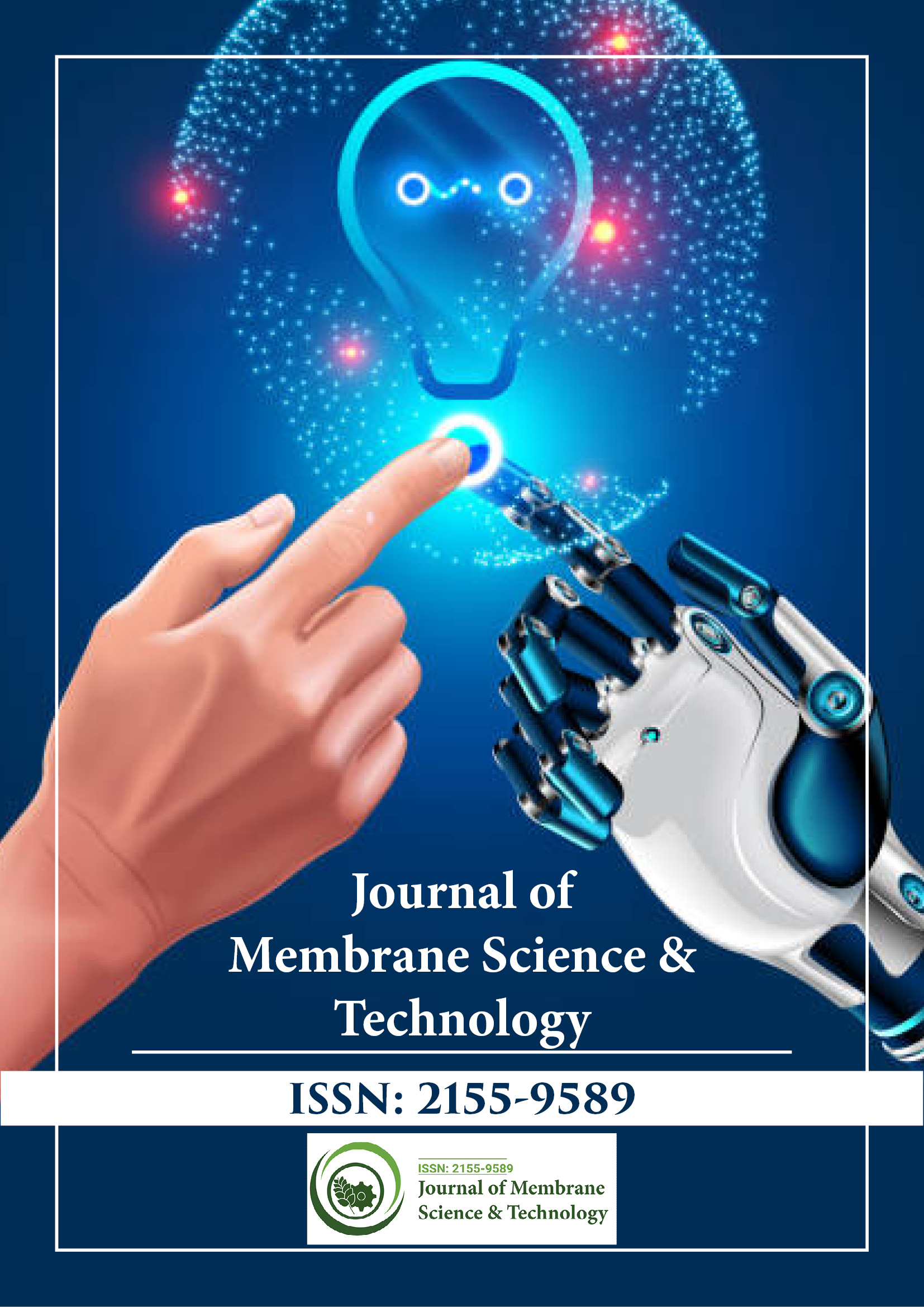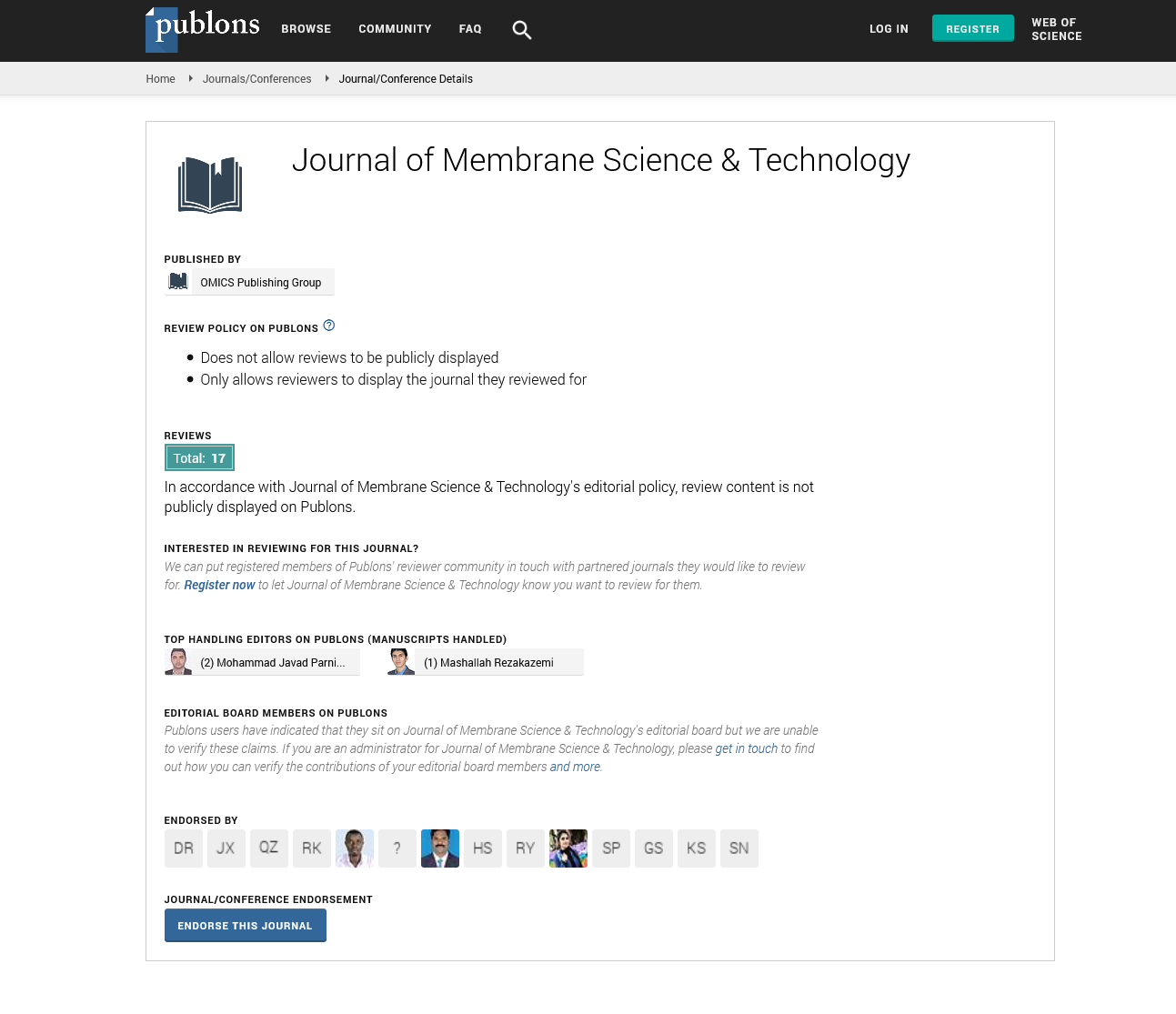Indexed In
- Open J Gate
- Genamics JournalSeek
- Ulrich's Periodicals Directory
- RefSeek
- Directory of Research Journal Indexing (DRJI)
- Hamdard University
- EBSCO A-Z
- OCLC- WorldCat
- Proquest Summons
- Scholarsteer
- Publons
- Geneva Foundation for Medical Education and Research
- Euro Pub
- Google Scholar
Useful Links
Share This Page
Journal Flyer

Open Access Journals
- Agri and Aquaculture
- Biochemistry
- Bioinformatics & Systems Biology
- Business & Management
- Chemistry
- Clinical Sciences
- Engineering
- Food & Nutrition
- General Science
- Genetics & Molecular Biology
- Immunology & Microbiology
- Medical Sciences
- Neuroscience & Psychology
- Nursing & Health Care
- Pharmaceutical Sciences
Opinion Article - (2025) Volume 15, Issue 2
Innovative Approaches in Membrane Module and Process Design for Enhanced Performance
Gede Wenten*Received: 30-Apr-2025, Manuscript No. JMST-25-29441; Editor assigned: 02-May-2025, Pre QC No. JMST-25-29441; Reviewed: 16-May-2025, QC No. JMST-25-29441; Revised: 23-May-2025, Manuscript No. JMST-25-29441; Published: 30-May-2025, DOI: 10.35248/2155-9589.25.15.423
Description
Module and process design are fundamental components in the development and optimization of membrane-based separation systems. The efficiency, scalability and cost-effectiveness of membrane applications across various industries such as water treatment, food processing, pharmaceuticals and chemical manufacturing are heavily influenced by how membrane modules are configured and how processes are engineered around them. A well-designed module and process layout ensures maximum membrane utilization, optimal flow dynamics and minimized energy consumption, leading to better overall system performance and longevity.
A membrane module is a device that houses one or more membrane elements and provides the structural framework to support fluid flow, pressure control and separation operations. Several module types are used in industry, each suited for specific applications based on membrane material, process conditions and separation requirements. The most commonly used module configurations include plate-and-frame, spiralwound, tubular and hollow fiber designs.
Plate-and-frame modules consist of flat sheet membranes stacked between support plates, with spacers to maintain flow channels. These modules are easy to clean and maintain, making them suitable for applications involving viscous or high-fouling feeds, such as in dairy and food processing. However, they generally require more space and offer lower packing density compared to other configurations.
Spiral-wound modules are among the most widely used configurations, especially in reverse osmosis and Nano filtration systems. They are constructed by wrapping flat sheet membranes and spacers around a central permeate collection tube, creating a compact and high-surface-area design. Spiral-wound modules offer excellent packing density and are suitable for high-volume, low-viscosity fluids. However, they are more prone to fouling and can be difficult to clean, limiting their use in some challenging feed streams.
Tubular modules use membranes coated on the inside of rigid tubes, allowing the feed to flow through the lumen. These are robust and tolerate high solid contents, making them ideal for wastewater treatment and certain industrial processes. Although they offer lower surface area per unit volume, their resistance to fouling and ease of cleaning make them valuable in harsh conditions.
Hollow fiber modules are made of thousands of thin, porous fibers bundled together in a cylindrical housing. The feed can flow either inside the fibers (lumen side) or outside (shell side), depending on the application. Hollow fiber modules offer an extremely high membrane surface area in a compact volume and are commonly used in ultrafiltration and microfiltration for municipal water treatment and biopharmaceutical production. Their high packing density and low footprint make them attractive for large-scale operations, though their small diameter makes them more susceptible to plugging and damage under mechanical stress.
Beyond the physical configuration of modules, process design plays an equally important role in membrane system performance. Process design encompasses the selection of operating parameters, flow arrangements, staging and control systems that ensure effective separation, minimal energy usage and long-term membrane stability. Key considerations include transmembrane pressure, crossflow velocity, recovery rate and concentration polarization.
Transmembrane pressure is the driving force for permeation through the membrane. It must be optimized to achieve the desired flux while avoiding compaction or damage to the membrane structure. Crossflow velocity refers to the flow of the feed solution parallel to the membrane surface, which helps limit fouling by reducing the build-up of retained solutes. High crossflow velocities improve mass transfer but require more energy, so a balance must be achieved for economic operation. Recovery rate the percentage of feed water converted into permeate is another critical parameter. While high recovery improves water efficiency, it can also increase the concentration of solutes near the membrane surface, leading to scaling and fouling. Therefore, recovery is often optimized in stages, with inter-stage flushing or chemical dosing to mitigate these effects.
Concentration polarization occurs when solutes accumulate near the membrane surface, forming a boundary layer that increases osmotic pressure and reduces net driving force. Process design strategies such as turbulence promoters, flow spacers and optimized feed channel geometry help to minimize this effect and enhance membrane performance.
In multi-stage membrane systems, modules are arranged in series (staging) to achieve higher overall recovery and separation efficiency. For instance, in reverse osmosis desalination plants, a two-stage arrangement allows the first stage to operate at lower recovery, minimizing fouling risk, while the second stage treats the concentrate to extract more permeate. Inter-stage booster pumps or energy recovery devices can be integrated to maintain pressure and improve energy efficiency.
Automation and control systems are integral to modern membrane process design. Sensors and monitoring tools track parameters such as pressure, flow rate, conductivity and temperature in real time, allowing for proactive adjustments and early detection of fouling or system anomalies. Advanced process control using machine learning and predictive analytics is emerging as a powerful tool to optimize performance, reduce downtime and extend membrane lifespan.
Recent advancements in module and process design are also exploring hybrid systems that combine membrane processes with other technologies. Examples include Membrane Bioreactors (MBRs), which integrate biological treatment with ultrafiltration and Forward Osmosis-Reverse Osmosis (FO-RO) hybrid systems that exploit natural osmotic gradients for energyefficient water recovery. Such integrated designs offer improved separation capabilities, better energy profiles and greater resilience in variable feed water conditions.
Conclusion
Ultimately, effective module and process design is essential for maximizing the benefits of membrane technology. As industries continue to demand higher efficiency, lower operational costs and greater sustainability, innovations in module configuration and process engineering will play a critical role in expanding the capabilities and applications of membrane systems worldwide.
Citation: Wenten G (2025) Innovative Approaches in Membrane Module and Process Design for Enhanced Performance. J Membr Sci Technol. 15:423.
Copyright: © 2025 Wenten G. This is an open-access article distributed under the terms of the Creative Commons Attribution License, which permits unrestricted use, distribution and reproduction in any medium, provided the original author and source are credited.

